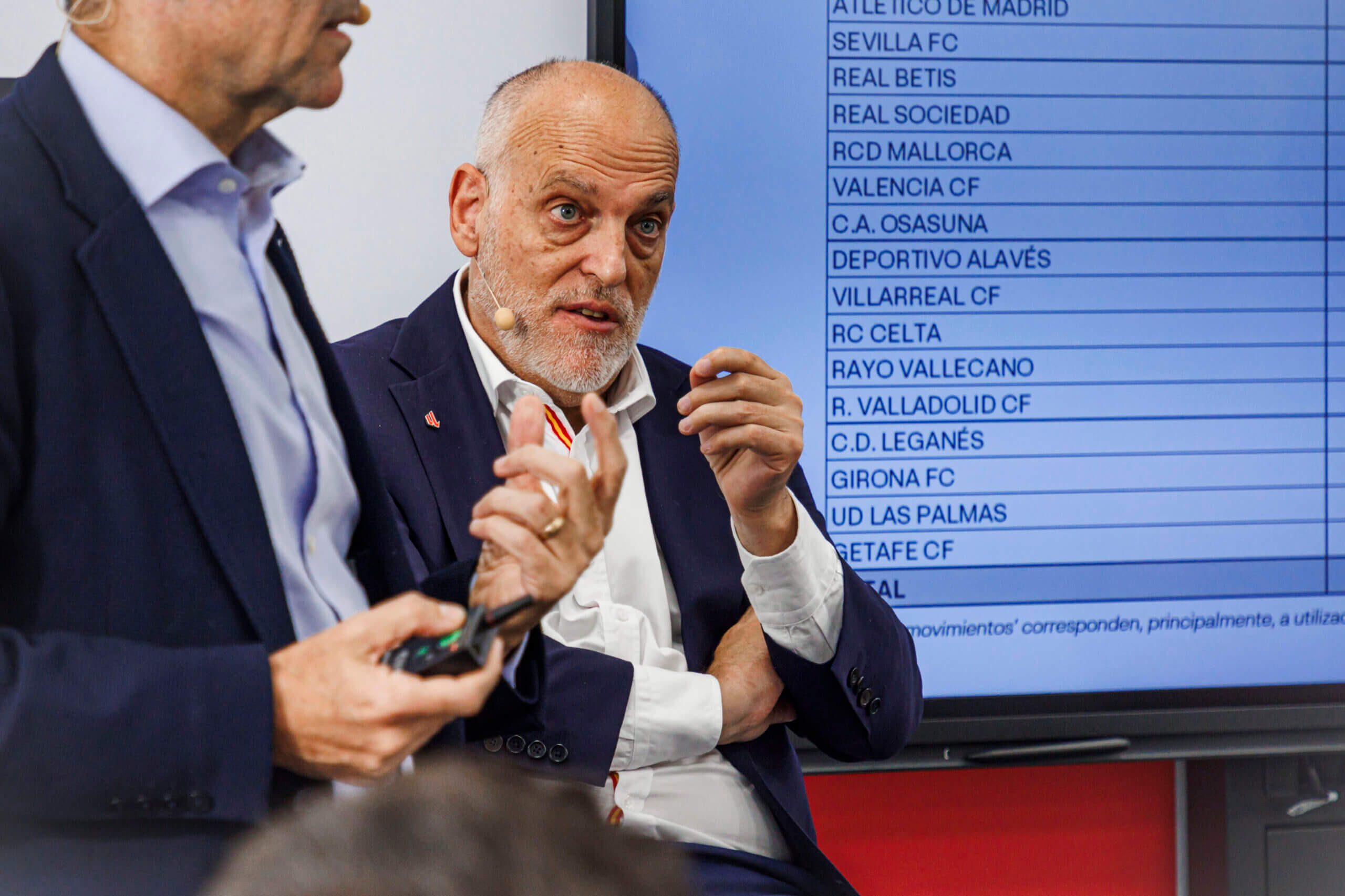Barcelona’s salary limit has been significantly raised by La Liga — to €426million (£359m; $470m) from €204m — although the Catalan club will still have to manoeuvre financially to register Dani Olmo for the second half of the 2024-2025 campaign.
New salary limits for all Spanish top-flight and second-division clubs were announced by La Liga on Thursday afternoon. Real Madrid continue to have by far the biggest at €755million — way ahead of their Clasico rivals.
Atletico Madrid are third at €311million and Real Sociedad are fourth at €160m, while financial issues at clubs such as Sevilla and Espanyol are clear from the severely restricted limits they have been set (€2.5m and €8.8m respectively).
As so often in recent years, much of the focus was on Barcelona’s situation. Here, The Athletic explains how La Liga’s salary limits are calculated, what Barca’s means for their summer signing Olmo and how they have continued to spend despite ongoing money problems.
Why does La Liga have a salary limit?
When Javier Tebas was first elected La Liga president in 2013, Primera and Segunda clubs had collective debts of over €2billion. More than half of that was owed to the Spanish government, with big sums also due to current and past players, coaches, staff and suppliers.
Tebas immediately introduced much stricter financial controls designed to force clubs to live within their means. Each club was given a limit to spend on transfer fees and salaries, based on their revenue generated each year.
“The thing I am proudest of is making Spanish football sustainable,” Tebas told The Athletic in an interview published in June 2023.
“Before, the clubs did not pay their taxes, or their players, or their suppliers. Now La Liga is financially sustainable — clubs only pay in salaries what they can raise in revenue.”
How does it work?
La Liga’s economic control department sets a total squad cost limit for each club each season. Levels are publicly announced twice a year — usually in early September after the summer transfer window shuts, and in early February following the winter transfer window.
All Primera and Segunda clubs have to provide documentation to La Liga throughout the year, showing their past revenues and projected income for the future.
Factors considered include expected revenues and outgoings for the coming season, but also profits and losses from previous years, overhead costs, non-player contracts, current savings, any existing debt repayments, investments and sources of external financing.
This squad cost limit is the total amount that clubs can spend on their first-team players, first-team coach, assistant coach and head physio, as well as their reserve teams, academy and any non-registered squad players.
How does the salary limit affect transfers?
Clubs may choose how the money is split between transfers or wages, provided the overall limit is not exceeded. Transfer fees are usually divided or ‘amortised’ over the term of a player’s contract — so an amount still due for players signed in previous seasons is counted within this squad cost limit.
Whenever a club looks to register a new player, using La Liga’s proprietary ‘La Liga Manager’ software system, its economic control team reviews the paperwork, including the transfer agreement with the other club and the player’s new contract.
Only when they are satisfied that a club has sufficient space in their budget to cover the transfer fee and salary can any new player be registered to play (in any competition).
Clubs that have exceeded their salary limit are also affected when they sell players — as the majority of money coming in must be put towards paying off past debts.
How has Barca’s salary limit evolved in recent years?
Barca have for some time now been struggling with their limits, which has see-sawed up and down through recent years.
The highest number reached for Barca’s official salary limit was €671million in 2019-20, just before the Covid-19 pandemic. As the full extent of the problems accumulated under former president Josep Maria Bartomeu became clear, it reached a low point of minus €144m in February 2022.
The limit has continued to fluctuate since, as Barca’s current president Joan Laporta has looked to fix the club’s finances using a levers policy which sold shares in club assets (such as future TV revenues) to provide up front money to sign and register expensive stars.
How can a club function with such a fluctuating limit, including a minus figure?
These limits are on paper, the results of complex mathematical formulas that La Liga do not make public. In the real world, clubs have to honour contracts already signed with players and other teams. So even when Barca’s salary limit was a negative €144million, they were actually spending around €560m on salaries and transfer fees in 2021-22.
“The negative limit doesn’t mean anything with regards to this season’s signings,” La Liga’s corporate general director Javier Gomez said in March 2022. “It means they will be limited more in future seasons, unless there are capital gains or profits.”
In the summer of 2022, when Barca’s ‘levers’ policy started and they raised over €800million by selling future TV rights and shares of the club’s media activities, their salary limit jumped by almost exactly that same figure. Much of that money was then spent on transfer fees and wages for stars such as Robert Lewandowski, Jules Kounde and Raphinha.
In November 2022, La Liga clubs voted to change their rules. Since then, money raised through sales of future assets is mostly not counted within salary limit calculations — and Barca’s salary limit fell significantly again.
Have other clubs had problems too?
Barca are the most high-profile, but plenty of other clubs have had issues registering players with La Liga in recent seasons.
In 2014, midfielder Pedro Leon was left in limbo when he refused to accept a pay cut to be registered at Getafe (he was eventually registered that November). In 2015, Elche were relegated from Primera to Segunda for financial reasons.

More recently, clubs who have exceeded their limit have been severely restricted in their transfer activity, motivating them to sell players and remove high-earners from their wage bill, thereby ‘forcing’ them to live within their means.
La Liga said on Thursday that nine clubs in Primera and Segunda are outside their salary limit after the summer window. Among those with the biggest problems are Sevilla and Espanyol. Other clubs including Real Betis and Real Valladolid also had to wheel and deal late in the window to be able to register their signings to play.
So what’s the latest on Barca and Olmo?
While Barca’s salary limit has been up and down in recent years, the club’s annual wage bill has been falling, as big earners including Lionel Messi, Antoine Griezmann, Gerard Pique, Ousmane Dembele, Sergio Busquets and Ilkay Gundogan have left.
However, they have also kept signing star players on significant wages — including Olmo this summer. So the total salary has generally still been above the allowed limit, making it all the time more difficult to be able to register players with La Liga.
In recent summers, Barca board members have signed personal bank guarantees promising to cover future revenues if they did not arrive, in order to register players such as Ronald Araujo, Marcos Alonso and Inigo Martinez.
Last January, Barca used La Liga’s rule 77, which allows clubs to replace long-term injured players, with new Brazilian signing Vitor Roque taking the place of sidelined midfielder Gavi.
After Araujo was injured at the Copa America in June, rule 77 was used to register Martinez. And it was used again in late August to temporarily register €60million new arrival Olmo when defender Andreas Christensen was injured.

Rule 77 is designed to give clubs flexibility in case a registered player suffers an injury that will keep them out for four months or longer. Initial estimations of Christensen’s recovery time were put at one month, but a La Liga source — speaking anonymously to protect their position — told The Athletic at the time that Barca had provided a medical report which met requirements for the rule to be applied.
“Barca registered Olmo until December 31 using rule 77,” said Gomez at Thursday’s presentation. “They now have time to find a way to raise their limit by January, so that they can register Olmo from January to June.”
Laporta said last week that he expects Barca to raise enough money in the coming months to raise their salary limit to a level which would be above their current expenditure on salaries. That would allow them to return to the ‘1:1 rule’ — when all money raised by the club can be spent on new players.
Barca have been trying to negotiate an extension to their kit deal with Nike, with the club hoping to increase the annual fee it receives, as well as a ‘signing bonus’ that could be used to fill a hole in its accounts caused by its problematic Barca Vision lever.
In the longer term, Barca need to increase their revenues and keep their salary costs under control. Returning to their Camp Nou stadium, which is currently redeveloped, will help with that.
(Top photo: Alex Caparros/Getty Images)





